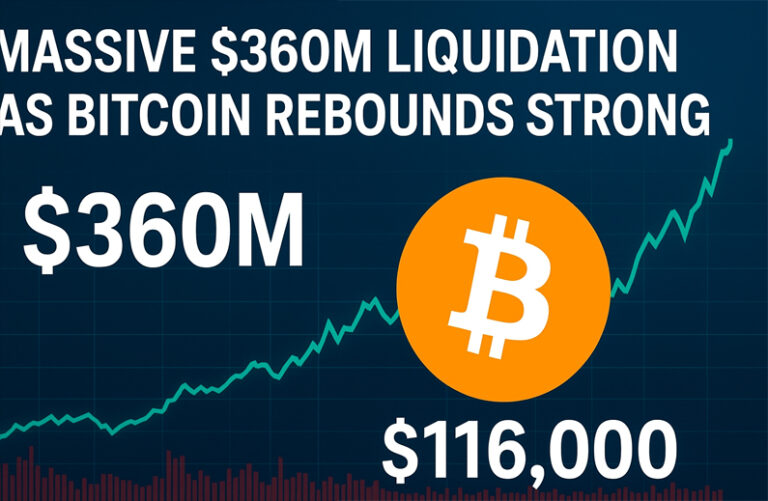Premium Biz Post – The cryptocurrency market witnessed dramatic volatility as Bitcoin surged to $116,000 following a sudden wave of short liquidations worth nearly $360 million. This event shook leveraged traders and reignited bullish sentiment across major digital assets. The Massive $360M Liquidation marks a critical turning point, showing how swiftly the market can reverse under extreme trading pressure.

Bitcoin’s Rapid Recovery Surprises the Market
After weeks of sideways movement and market indecision, Bitcoin’s sudden rebound has caught both traders and analysts off guard. The flagship cryptocurrency had been hovering around the $105,000–$108,000 range before an unexpected short squeeze sent prices soaring past the $116,000 mark in just a few hours.
According to data from several major exchanges, the move liquidated more than 60,000 positions—mostly from traders betting against Bitcoin’s short-term growth. Analysts believe that the sharp rise was triggered by a combination of thin liquidity, leveraged bets, and renewed optimism following institutional inflows into Bitcoin exchange-traded funds (ETFs).
The Mechanics Behind the Short Squeeze
A “short squeeze” occurs when traders who have bet on a price decline (short sellers) are forced to buy back their positions as prices rise, pushing the market even higher. This cycle feeds on itself, resulting in a steep upward movement.
In this case, Bitcoin’s move from $108,000 to $116,000 happened within a 12-hour window. Data from CoinGlass showed that approximately $360 million worth of short positions were wiped out during that period. Major exchanges such as Binance, OKX, and Bybit reported record liquidations—an indicator of heightened volatility.
Market strategist Edward Harper noted,
“When a market like Bitcoin is heavily shorted, even a small burst of positive momentum can trigger a cascade of forced liquidations. That’s exactly what we saw this week.”
The event also pushed funding rates—the cost of holding leveraged positions—into positive territory, signaling that more traders are now betting on price increases rather than declines.
Institutional Investors Step Back In
Another factor fueling Bitcoin’s rebound has been the renewed participation of institutional players. Data from CoinShares indicated that digital asset investment products saw inflows exceeding $1 billion over the past week, marking the strongest institutional demand since mid-2024.
Investment firms such as Bitwise and Canary Capital are also preparing to launch the first U.S.-based altcoin ETFs, including products tied to Litecoin and Hedera. This expansion of institutional-grade crypto products has improved investor confidence, not only for Bitcoin but for the broader digital asset ecosystem.
Institutional demand often acts as a stabilizing force in volatile markets. When large funds enter, they bring liquidity, long-term perspective, and reduced speculative pressure. As such, Bitcoin’s latest rally could signal a more sustainable trend rather than a short-term anomaly.
Ethereum and Altcoins Follow the Momentum
While Bitcoin grabbed headlines, other cryptocurrencies also benefited from the bullish momentum. Ethereum (ETH) climbed past $3,400—its highest level in over two months—following reports that investment firm BitMine increased its Ether holdings to more than $14 billion.
Altcoins like Solana (SOL), Avalanche (AVAX), and Chainlink (LINK) also saw gains between 6% and 12% within 24 hours. This broad-based rally suggests a return of investor appetite for risk assets in the digital currency sector.
However, analysts caution that altcoins remain more vulnerable to volatility compared to Bitcoin. “Altcoins tend to outperform during bullish phases, but they also fall harder when sentiment shifts,” said crypto researcher Maya Liu. “Traders should remain disciplined and manage risk carefully.”
Read More : ”Electronics in One Creation A Unified Technology for Modern Solutions”
The Role of Derivatives in Market Volatility
Derivatives—particularly perpetual futures—play a central role in crypto market dynamics. They allow traders to speculate on price movements using leverage, amplifying both gains and losses. When large numbers of leveraged positions accumulate, it creates the conditions for violent liquidations, as seen in the latest Bitcoin move.
The $360 million liquidation event demonstrates how over-leveraging can trigger cascading effects across exchanges. Even a small percentage move in price can set off automatic liquidations, leading to amplified volatility.
Derivatives exchanges have attempted to mitigate this through better margin controls and automated liquidation mechanisms. Yet, with the rise of retail participation and algorithmic trading, sudden liquidations remain a recurring feature of the crypto landscape.
Macroeconomic Factors at Play
Beyond the crypto-native dynamics, macroeconomic conditions have also supported Bitcoin’s recovery. A weaker U.S. dollar, falling Treasury yields, and growing speculation of a Federal Reserve rate cut have pushed investors toward alternative assets like Bitcoin.
Historically, Bitcoin has performed well during periods of monetary easing or uncertainty about fiat currency stability. The narrative of Bitcoin as “digital gold” continues to resonate, especially as inflationary pressures persist in global markets.
Financial analyst Jordan Hayes commented,
“As traditional markets face inflation and political uncertainty, Bitcoin’s decentralized nature offers an attractive hedge. The recent rebound underscores its growing role as a macro asset, not just a speculative play.”
Market Sentiment Turns Bullish Again
Sentiment indicators such as the Fear & Greed Index show a notable shift toward optimism. After hovering in the “neutral” zone for weeks, the index surged to 73—indicating “greed.” Social media mentions of “Bitcoin breakout” and “short squeeze” also spiked by more than 40% in 24 hours, according to LunarCrush analytics.
Retail traders have re-entered the market, while long-term holders (often referred to as “whales”) have reduced their selling activity. On-chain data shows that the amount of Bitcoin held in cold storage wallets continues to rise, suggesting accumulation rather than distribution.
However, experts warn against overconfidence. “Short-term rallies fueled by liquidations can create false optimism,” said Glassnode’s lead analyst. “If the rally isn’t supported by organic spot buying, corrections are still possible.”
Technical Analysis: Key Levels to Watch
From a technical perspective, Bitcoin faces resistance near the $118,500–$120,000 zone. A successful breakout above that range could open the path toward $125,000, while failure to hold above $112,000 may trigger another round of profit-taking.
Moving averages (MA50 and MA200) indicate a bullish crossover pattern, confirming upward momentum. Meanwhile, the Relative Strength Index (RSI) remains in a healthy 62–65 range—suggesting there’s still room for further upside before overbought conditions emerge.
Traders are also watching for volume confirmation. Sustained volume increases during rallies typically indicate genuine buying pressure rather than speculative spikes.
Regulatory Developments and Investor Caution
While the rebound has renewed optimism, regulatory uncertainties remain a key concern. Several jurisdictions, including the United States and the European Union, are tightening rules on crypto exchanges and stablecoins. The implementation of stricter Know-Your-Customer (KYC) and Anti-Money Laundering (AML) standards could impact liquidity and trading behavior.
Additionally, cybersecurity threats and scam activities continue to plague the sector. Experts urge investors to prioritize security by using reputable exchanges, hardware wallets, and two-factor authentication.
Regulatory clarity, if done correctly, could ultimately strengthen the market by fostering trust and institutional participation. However, excessive restrictions might dampen innovation and decentralization—the core principles that underpin cryptocurrencies.
The Road to $120,000 and Beyond
As Bitcoin stabilizes above $115,000, traders are closely watching whether it can sustain momentum and challenge new highs. The Massive $360M Liquidation as Bitcoin Rebounds Strong event has not only shaken out weak hands but also reawakened global interest in digital assets.
If institutional inflows continue and macroeconomic conditions remain favorable, Bitcoin could be on track for a renewed bull cycle leading into 2026. However, investors should remain vigilant, as volatility is likely to persist.
In the words of veteran trader Scott Melker:
“Bitcoin always climbs a wall of worry. What looks like chaos to outsiders often becomes opportunity for those who understand its cycles.”
The recent $360 million liquidation serves as a powerful reminder of the crypto market’s volatility and resilience. Bitcoin’s rebound to $116,000 highlights both the risks of over-leverage and the potential rewards of staying patient during downturns.
For investors and traders alike, the key takeaway is balance—embrace the innovation and growth potential of crypto, but remain disciplined, informed, and ready for the unpredictable waves that define this ever-evolving market.


